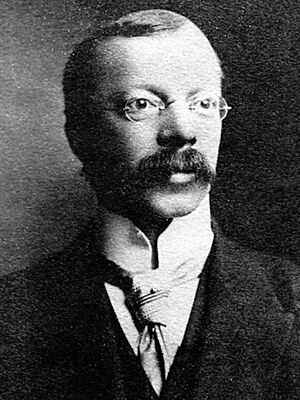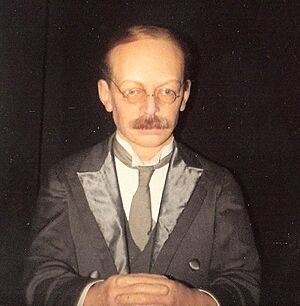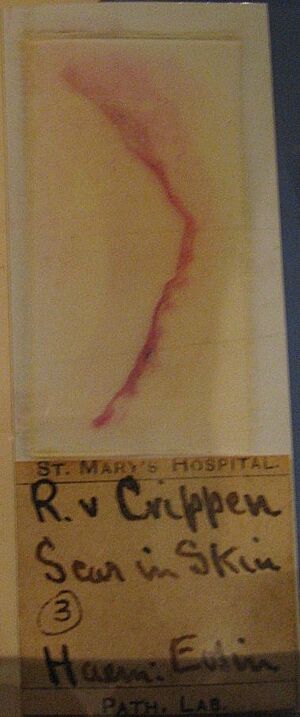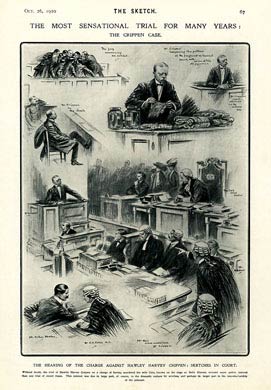Hawley Harvey Crippen facts for kids
Quick facts for kids
Hawley Harvey Crippen
|
|
|---|---|

Crippen, c. 1910
|
|
| Born | September 11, 1862 |
| Died | November 23, 1910 (aged 48) Pentonville Prison, London, England
|
| Cause of death | Execution by hanging |
| Resting place | HM Prison Pentonville |
| Occupation | Homeopath |
| Known for | First suspect to be captured with the aid of wireless telegraphy |
| Criminal status | Executed |
| Spouse(s) | Charlotte Crippen (died 1892) Corrine Henrietta Turner
(m. 1894; died 1910) |
| Conviction(s) | Murder |
| Criminal penalty | Death |
| Details | |
| Victims | Corrine Henrietta Crippen |
| Date | c. January 31, 1910 |
|
Date apprehended
|
July 31, 1910 |
Hawley Harvey Crippen (born September 11, 1862 – died November 23, 1910), often called Dr. Crippen, was an American doctor. He worked as a homeopath and specialized in ear and eye care. He was found guilty of murdering his wife, Cora Henrietta Crippen, in London. He was later executed at Pentonville Prison. Dr. Crippen became famous for a special reason. He was the first criminal ever caught with the help of wireless telegraphy, which is an early form of radio communication.
Contents
Dr. Crippen's Early Life and Work
Hawley Crippen was born in Coldwater, Michigan. He was the only child of Andresse Skinner and Myron Augustus Crippen. His father was a merchant. Hawley studied at the University of Michigan's homeopathy school. He then graduated from the Cleveland Homeopathic Medical College in 1884.
In 1892, his first wife, Charlotte Jane, passed away. Crippen then asked his parents to care for his son, Hawley Otto. They lived in San Jose, California.
Crippen began his medical practice in New York City. In 1894, he married his second wife, Corrine "Cora" Turner. She was a music hall singer known as Belle Elmore. That same year, Crippen started working for a famous homeopath named James M. Munyon. In 1897, he and Cora moved to London. Crippen went there to manage Munyon's office.
Crippen's medical degrees from the United States were not enough for him to work as a doctor in the United Kingdom. He continued to sell patent medicines. Cora tried to become a successful stage performer, but she did not succeed. She spent time with other performers of that era.
In 1899, Munyon fired Crippen. He then worked for other medicine companies. Later, he became the manager for the Drouet Institute for the Deaf. In 1900, he hired a young typist named Ethel Le Neve. Crippen and his wife lived in several places in London. They finally moved to No. 39 Hilldrop Crescent in Holloway. They rented out rooms to help with Crippen's low income.
The Disappearance and Investigation
On January 31, 1910, Cora Crippen disappeared. This happened after a party at their home in Hilldrop Crescent. Crippen told people that Cora had gone back to the United States. He later claimed she had died and was cremated in California. Meanwhile, Ethel Le Neve moved into the house. She started wearing Cora's clothes and jewelry openly.
Cora's friend, the strongwoman Kate "Vulcana" Williams, first told the police about her disappearance. But the police took it more seriously later. Two other friends, actress Lil Hawthorne and her husband John Nash, asked Scotland Yard to investigate. They knew Superintendent Frank Froest. The police searched Crippen's house, but they did not find anything.
Chief Inspector Walter Dew questioned Crippen. Crippen admitted he had lied about his wife dying. He said he made up the story to avoid embarrassment. He claimed Cora had left him for another man, a music hall actor named Bruce Miller. Inspector Dew believed Crippen's story at first.
However, Crippen and Le Neve did not know this. They panicked and ran away to Brussels. They stayed there for one night. The next day, they went to Antwerp. They boarded a ship called the SS Montrose, which was going to Canada.
Because the couple disappeared, the police searched the house again. During the fourth search, they found Cora's remains. Her remains were buried at the St Pancras and Islington Cemetery, East Finchley.
The Chase Across the Atlantic
While Crippen and Le Neve were on the Montrose, they were crossing the Atlantic Ocean. Le Neve was dressed as a boy to hide her identity. The ship's captain, Henry George Kendall, recognized the two fugitives. Just before his ship went out of range of its radio, he sent a wireless telegram to the British police. The message said he strongly suspected Crippen and his helper were on board. He noted Crippen had shaved his mustache and was growing a beard. He also said the "boy" was clearly a girl. If Crippen had traveled in third class, the captain might not have noticed him.
Inspector Dew quickly boarded a faster ship, the SS Laurentic, from Liverpool. He arrived in Quebec, Canada, before Crippen's ship. Dew contacted the Canadian authorities.
As the Montrose sailed into the St. Lawrence River, Inspector Dew came aboard. He was disguised as a pilot. At that time, Canada was part of the British Empire. If Crippen, an American citizen, had gone to the United States instead, it would have been harder to bring him to trial. This is because of special legal steps called extradition.
Captain Kendall invited Crippen to meet the pilots coming aboard. Dew took off his pilot's cap and said, "Good morning, Dr. Crippen. Do you know me? I'm Chief Inspector Dew from Scotland Yard." After a moment, Crippen replied, "Thank God it's over. The suspense has been too great. I couldn't stand it any longer." He then held out his wrists for handcuffs. Crippen and Le Neve were arrested on the Montrose on July 31, 1910. Crippen was brought back to the UK on the ship SS Megantic.
The Trial and Outcome
Crippen's trial took place at the Old Bailey in London. It was overseen by the Lord Chief Justice, Lord Alverstone. The trial started on October 18, 1910, and lasted for four days.
The jury decided Crippen was guilty of murder very quickly. They took only twenty-seven minutes to reach their decision. Ethel Le Neve was charged with helping Crippen after the crime. However, she was found not guilty.
Crippen's Execution
Crippen was executed by John Ellis. This happened at Pentonville Prison in London. The execution took place at 9 AM on Wednesday, November 23, 1910.
After the trial, Ethel Le Neve traveled to the United States. She later settled in Canada and worked as a typist. She returned to Britain in 1915 and passed away in 1967. Crippen had a special request. He asked for a photograph of Le Neve to be placed in his coffin. It was buried with him.
Crippen's grave at Pentonville is not marked with a stone. But it is said that a rose bush was planted over it soon after his burial. Some of his family members in Michigan have recently started asking for his remains to be brought back to the US.
Dr. Crippen in Books and Movies

The story of Dr. Crippen has inspired many creative works.
- The case led to an Australian play in 1910 called By Wireless Telegraphy.
- The murder also inspired a short story by Arthur Machen in 1927. This story was later made into a Mexican film in 1960.
- A 1942 German film, Doctor Crippen on Board, starred Rudolf Fernau as Crippen.
- The 1961 musical Belle, or The Ballad of Dr Crippen was based on the case.
- The British film Dr. Crippen from 1962 starred Donald Pleasence in the main role.
- The 2006 book Thunderstruck by Erik Larson tells Crippen's story. It also talks about Guglielmo Marconi's invention of radio.
- The PBS series Secrets of the Dead had an episode in 2008. It explored new findings about the Crippen case.
- In the book A Fantastic Fear of Everything, a character believes Dr. Crippen has returned to kill him.
See also
- John Reginald Christie, English serial killer
- John George Haigh, English serial killer
- Michael Swango, American serial killer
- John Tawell, British murderer and the first criminal to be captured with the use of telecommunications technology
- Dorothea Waddingham, English nursing home matron and murderer





